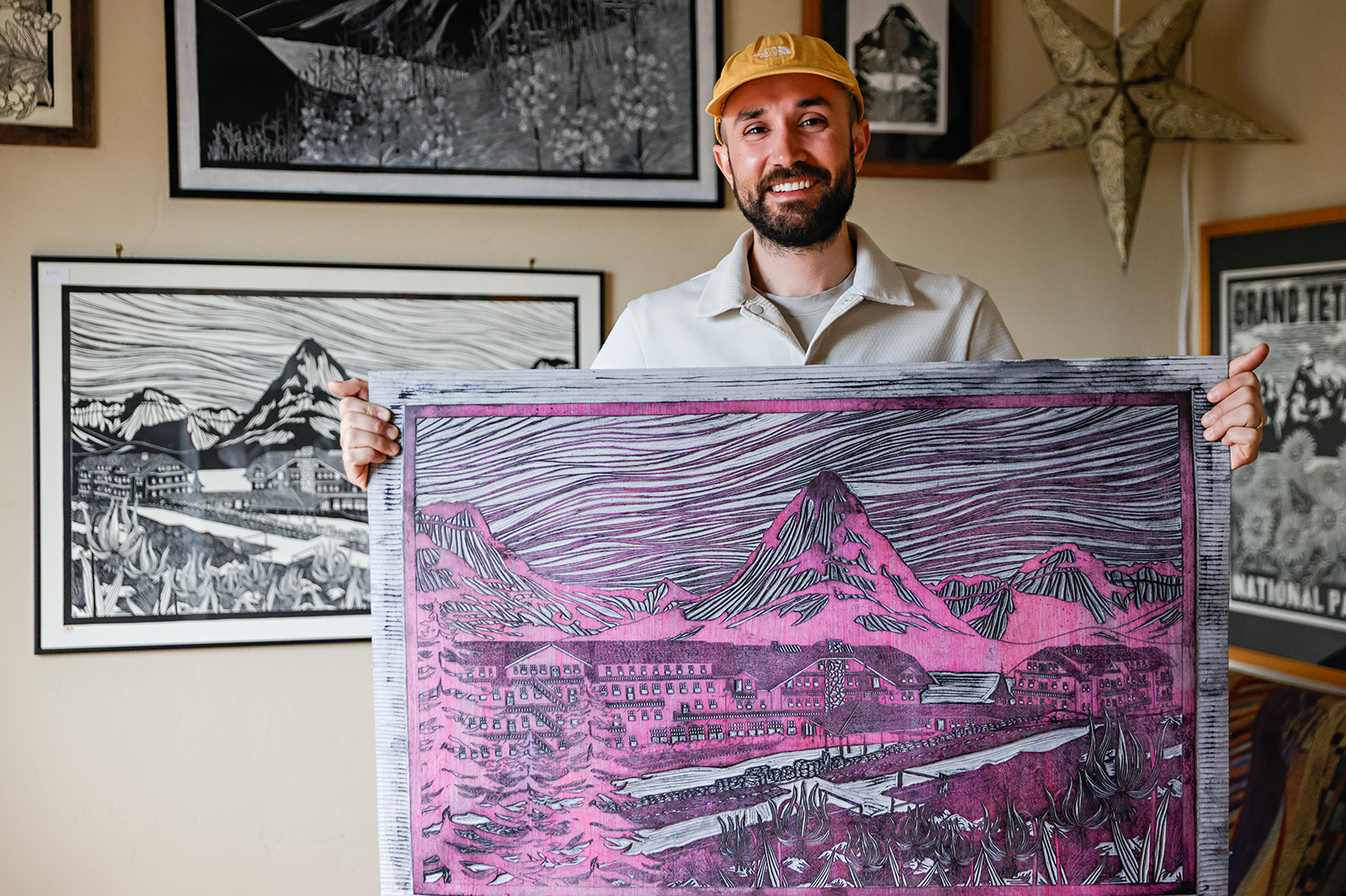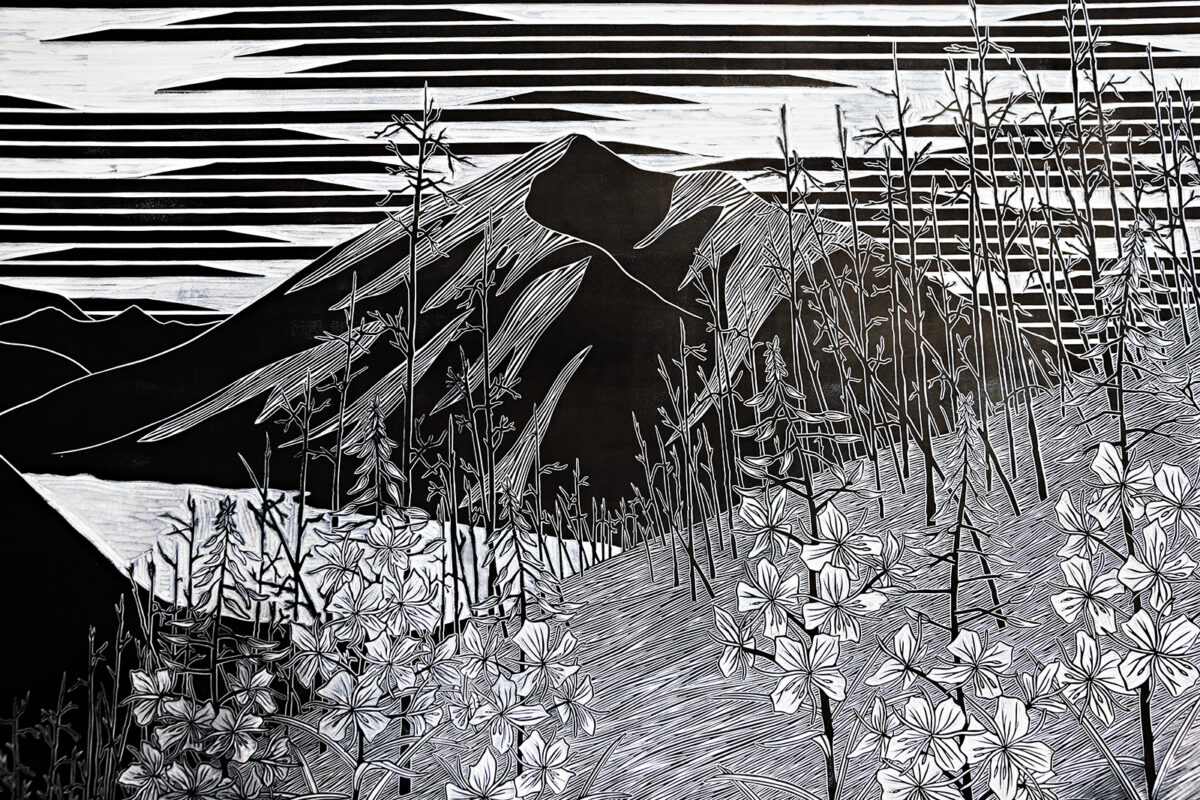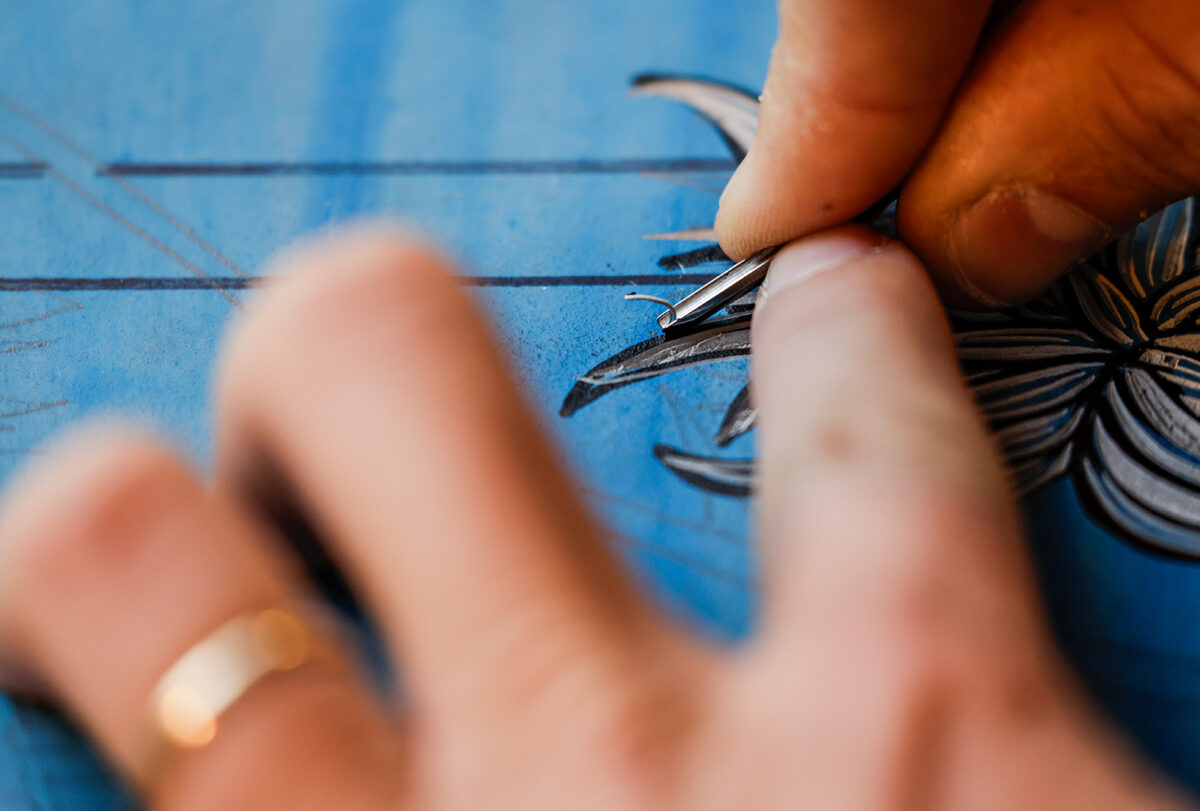For Whitefish Artist and Printmaker Tarek Penser, an Image is Worth a Thousand Lines
It’s hard to pinpoint exactly square one in Penser’s own journey to becoming an artist, but he’s adamant that no one is born an artist
By Mike Kordenbrock
There are levels to the way in which the patience of Tarek Penser has paid off in his creative life. Patience played a role, consciously or not, in his development into an artist, which took place over the course of years, and involved the completion of an engineering degree and working an office job. And it pays off in his work — linocut prints of varying sizes that rely on thousands of small carved lines to create a sense of depth, shadow, nearness, and contrast.
His subject matter, too, is often material that speaks of patience. There’s nothing rushed about northwest Montana’s mountain ranges and meadows, created through geologic processes occurring over millennia. Nor is there a hurried sense in the images of flowers that Penser creates, often after hiking to find them in bloom following months spent waiting beneath the dirt and snow. There aren’t many quick ways to the Polebridge Mercantile, either. And the same goes for the fire lookouts that he’s sometimes chosen to depict.

Gesturing to a scene of the Many Glacier Hotel on a recent spring morning, Penser says that it took him 200 hours of carving, which equates to about two months of work. It’s a long journey to get from an image to a sketch to a final carved block and successful print, and the artistic medium in which Penser works is also an unforgiving one. Mistakes can’t be undone. Sometimes they can be disguised or incorporated into the design. Other times, it can mean starting over.
“Everything that I make has some small flaw. It’s part of making things with your hands. I think that’s okay,” Penser said.
It’s hard to pinpoint exactly square one in Penser’s own journey to becoming an artist, but he’s adamant that no one is born an artist, and that he’s no exception. Raised and educated in Sweden, Penser, now 30, said he’s always been a creative person, but that he also remembers doing poorly in art classes as a kid, and quickly dropping those classes to pursue an academic track more focused on science and math.
“I always loved building things, and that was kind of what led me to engineering and product design,” he said.
Engineering school created opportunities for him to sketch, albeit in the way that modern engineers utilize drawings to quickly convey an idea to a client, before using a computer to eventually build out depth and detail for a more full-fledged design. Still, he developed a love for the small drawings, and in so doing took another critical step to where he is today.
“I have a feeling it’s not super common for mechanical engineers to take sketching classes in school, but the program that I was in was under the mechanical engineering faculty, but specifically about trying to bridge the gap between industrial or what we in Sweden call industrial design, but I guess (here) it would be like product design and mechanical engineering,” Penser said.
Growing up, he often left Sweden to visit family in the Flathead, including his aunt Andrea Brew, who is also a Whitefish-based artist. Over the years he’s worked as a captain for the Glacier Park Boat Company, and as a guide for Glacier Guides and Montana Raft Company.
Sometime in 2020, after he wrapped up his time as a backpacking guide, and while he was working on finishing his master’s in engineering from the KTH Royal Institute of Technology in Stockholm, Penser said that he decided to build off his love of sketching and take up printmaking, and as he started to experiment, something clicked in his brain about how to build scenes the way he wanted to.
“I don’t know how to explain that any better way,” he said. “It was just the right medium for how I see things.”

One of his early projects was a set of three prints, which he gifted to his wife Andrea for Christmas during the pandemic before they were married. At the time he made the pieces, they were living in different cities, and essentially stuck because of the various travel restrictions in place. So he set about making a print of the city where he was, a print of the city where she was, and a print of Whitefish, which is where they wanted to come back to. He delivered the prints to her when he got to see her for the first time in a year.
“We don’t have a ton of my art up in here,” Penser said, gesturing to a kitchen wall of his home which is covered in framed posters, paintings and prints. “But those are the three pieces of mine that go on the wall.”
After he got his master’s in engineering, Penser said that he started off working for an electric moped and motorcycle company called Cake. Eventually he took a job working for Nomad in Columbia Falls. Around that time, his printmaking practice started to build momentum.
“It turned into selling some prints to friends, then it turned into selling some prints to people that I didn’t know, and suddenly it was a little bit too big to ignore,” Penser said. “And so it reached a point where it felt like it was the right time to see if it was something that I could do full time. And that was two years ago. And it was definitely, at the time, I wanted to try it, but I did not have the intention to keep on doing it. And I don’t know, something about this place, the people have been so supportive and been so kind. It’s really a pretty awesome place to be an artist.”

In refining his methods and materials, Penser said that he believes his engineering background has been especially useful because it taught him about process and experimentation.
“And since I didn’t go to art school, that was how I learned to make things.”
That meant ordering all of the different materials that could be applicable, like ink, for example, and testing them out to see what worked for his goals.
He often takes photos of images while on hikes or camping trips, that he then converts into print sketches and then digital designs, which are eventually transposed onto linoleum blocks with what’s essentially a kind of carbon copy material called transfer paper.

The linoleum is then carved with the design using small, sharp hand tools called gouges. They come with a variety of different shaped tips in different sizes that can determine the type of lines they carve. Penser said that his preference is the super fine v-tip gouge, which gives him the highest level of precision.
“I don’t mind working on something for hours and hours,” he said.
Early on, he said he had a tendency to create works that were “over-carved,” meaning that they were lacking in the necessary contrast, often because there was too much grayscale produced by finely carved lines which when viewed at a distance can create the illusion of gray. Contrast is also achieved by the organization of the piece, and what kind of proximity black, white and gray components have to each other.
“It’s all about contrast,” he said.
To check out more of Tarek Penser’s work, go to https://www.tareksprints.com/.
This is the first in a two-part series of profiles of Tarek Penser and Sydney Boveng, two Flathead Valley artists who were selected for this summer’s Artist-Wilderness Connection residency, which is sponsored by the Glacier Art Museum, the Bob Marshall Wilderness Foundation, and the Flathead National Forest.
As part of their residency, Penser and Boveng will spend a week in a cabin on the east side of the Bob Marshall Wilderness. The two artists will be creating individual works inspired by the natural scenes around them, but in their distinct styles. They will also collaborate by creating works of art using reference sketches from each other. Check back in later this week to read our profile of Kalispell artist Sydney Boveng.